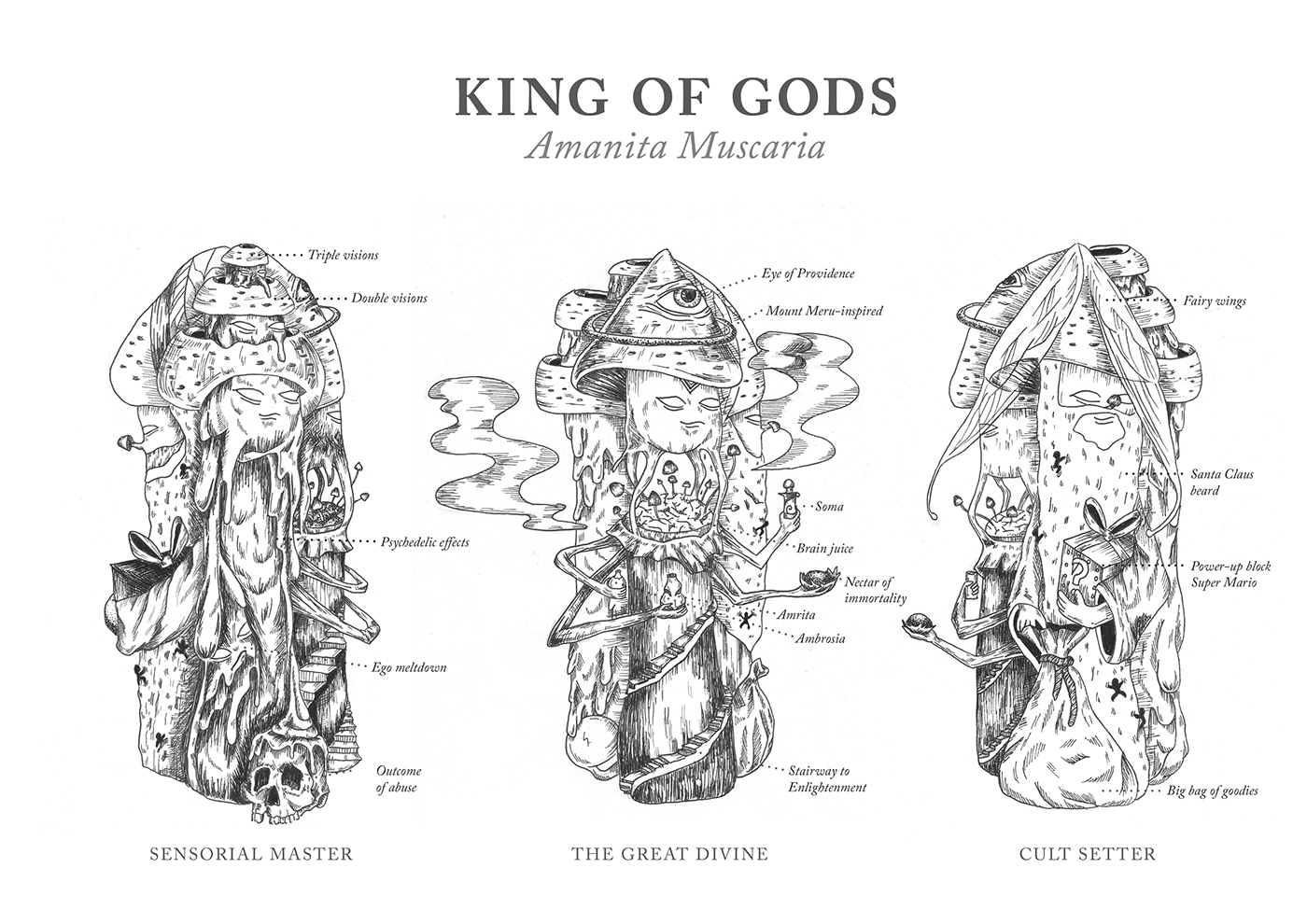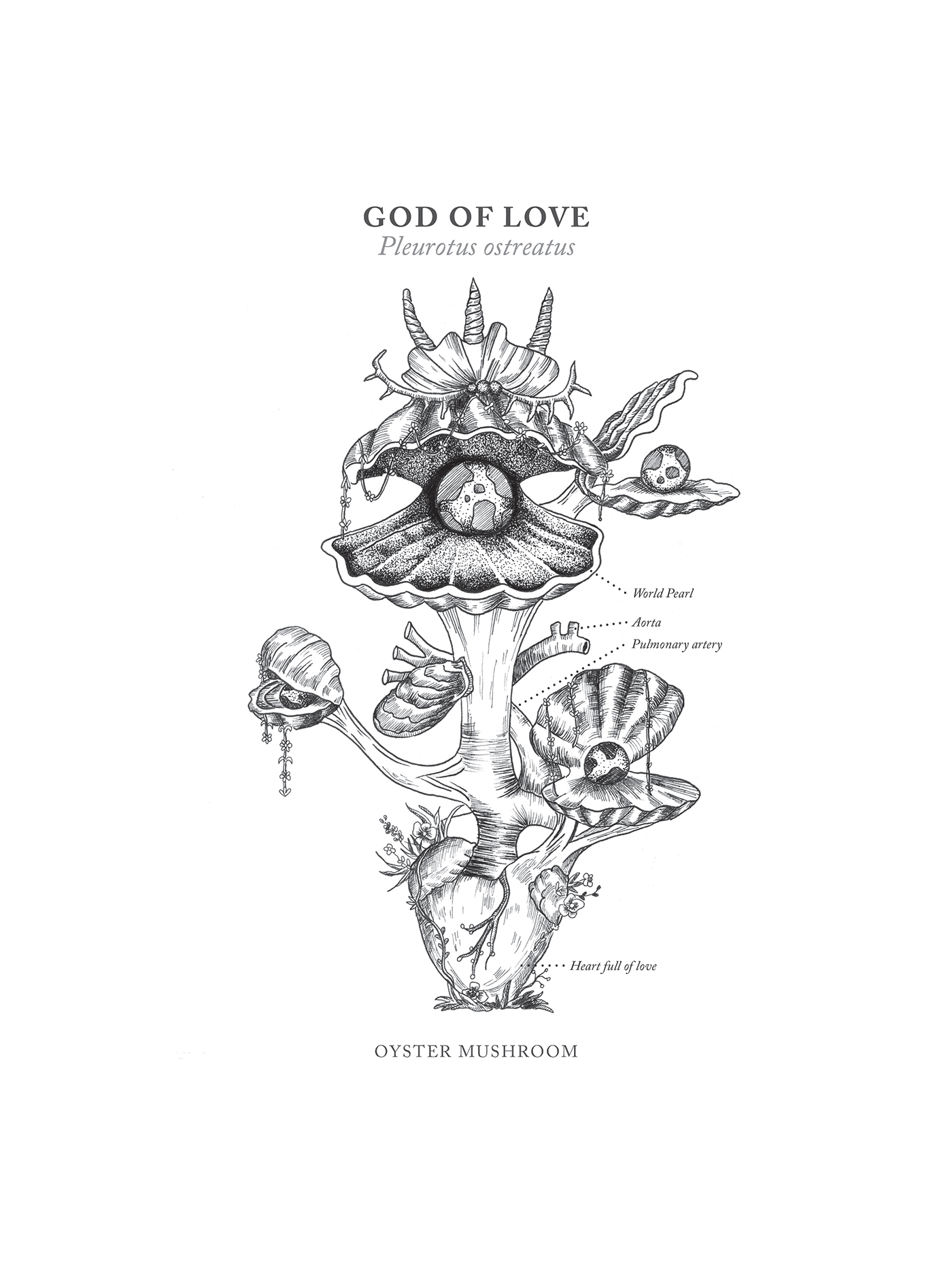

introduction
In the time that you conjure the image of a brown, stumpy and moist mushroom, Fungi have already shape-shifted and evolved a thousand times over. Fungi exist in unimaginable shapes, colours and sizes; we as humans have only seen but a fraction of it.
These fungi have a myriad of attributes and unfathomable power that make them more godly than gods. Some have the ability to revive themselves, while some can prolong the lives of others. They create their own weather, and produce magical chemicals that can send us into a different dimension. They cure the incurable, and can also of course, kill us painfully. Fungi have always been there, supporting the ecostructure as all of us evolve overtime. Without them, life would not have reached such complex stages.
The Codex Fungide then acts as a basic visual guide into the cosmos of Mycotheism, introducing the Fungi gods at the different realms at a very superficial level. As information about these gods are still limited and subject to translation of the holy scripture, some parts of the Fungide may still remain a mystery.
These fungi have a myriad of attributes and unfathomable power that make them more godly than gods. Some have the ability to revive themselves, while some can prolong the lives of others. They create their own weather, and produce magical chemicals that can send us into a different dimension. They cure the incurable, and can also of course, kill us painfully. Fungi have always been there, supporting the ecostructure as all of us evolve overtime. Without them, life would not have reached such complex stages.
The Codex Fungide then acts as a basic visual guide into the cosmos of Mycotheism, introducing the Fungi gods at the different realms at a very superficial level. As information about these gods are still limited and subject to translation of the holy scripture, some parts of the Fungide may still remain a mystery.
inSPIRATION
This project was stemmed from my love for mushrooms which began eons ago. It all started one fateful day with a bowl of Cream of Wild Forest Mushroom Soup. Since that very tasting, I had to have mushroom soup everyday for a long while, and the obsession materialised into a huge collection of all things mushrooms. While people forage for mushrooms as a hobby, I collect inanimate ones in the form of stuffed toys, knick-knacks and accessories, and it would give me the same profound satisfaction. One could say my love for mushrooms was almost... religious.
APPROACH
In an effort to parody reality while basing visual metaphors on scientific fact, everything imagined and illustrated in this project is based on the interesting features of real and unique species of fungi. This project acts as a gateway into the fantasy world of fungi, where these amazing qualities of the fungi are highlighted through the eyes of a mushroom fanatic.

COSMIC MAndala
The traditions of constructing a mandala have helped me visually map out the systems and cosmos of Mycotheism. In Buddhism and Hinduism, mandalas are 2D visual representations of the cosmos, often simplifying complex concepts.
Similarly, the cosmic mandala of Mycotheism maps out all the existing realms, and where Myain deities reside in them. The mandala is positioned this way because the crux of this religion is about life, death and the in-between.
Outer ring
Physical realm in macro-perspective
This is the realm of things that we can see, and the conscious. It is also known as reality. Life and death sit on this realm, together with the Gods of Wisdom, Adaptability, Health, Celebration, Destruction and Death.
Inner square
Physical realm in micro-perspective
This is the realm of things that are far too small to be visible to the naked eye or even the subconscious. The Gods of Hope, Healing, Remediation and Soul Liberator belong to this realm. A ladder links the God of Death in the macrocosm to the Soul Liberators in the microcosm. This ladder represents the different levels of physical
hell immoral people suffer before dying.
Central ring
Metaphysical realm of the superconscious
This is where the King of Gods, God of Love and Happiness is found, because their powers are intangible. Its impact can only be felt, not seen.



Mycotheism reveres the process of our spirits returning to the living consciousness that surround us — that of Myco-organisms. It concerns the decomposition of the human body and the deconstruction of our physical and metaphysical self. In the diagram above, the black-filled circle represents our consciounsesss, while the circle around it is our physical bodies. When we die, Soul Liberators will decompose us and separate this consciousness from the physical body. Our consciousness moves on to get assimilated into Eternity, where it faces salvation or damnation in the Fungatory. Meanwhile, our physical bodies disintegrate to become in universal oneness with the Myco-organisms in the physical world.


The world of fungi in Mycotheism has been divided according to their ranks and importance for ease of understanding. In total, there are 5 ranks, namely Myain Deities, Mycodeities, Demideities, Semideities and myco beings.
The Myain Deities are the most important as they are responsible for balancing and connecting the physical (we live here) and metaphysical realms. There are 13 Myain Deities, and they are all chiefs of their own subcategories.
Mycodeities are major gods that areimportant as well, however, they are less commonly worshipped and needed by people as compared to Myain deities.
Demideities and Semideities are minor gods that have yet to attain enlightenment or realise their full potential. The only difference here is, Semideities look an awful lot like human organs. They retain a strong affinity with their past, and hence have human-like features because they were previously humans.
As for myco beings, they are just odd fungi with no special powers, other than being interesting to look at.
These gods can also be classified based on their divination methods. Active gods would be the ones that people have to ingest, in order for the works of god to take effect, while inactive gods would share their blessings or curse when people pray to it.







OFFICIAL PUBLICATION
The Codex Fungide is a sacred religious book which is an equivalent to the Bible or Quran. It introduces the religion, Mycotheism, through a series of illustrations of the Fungi gods and the realms that they reside in, as well as visual diagrams and explanations for the philosophies and cosmologies behind this religion.















